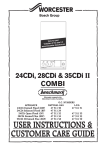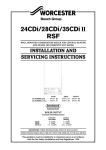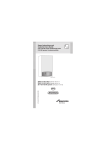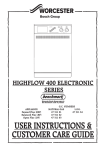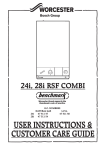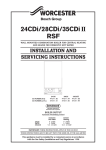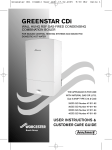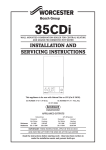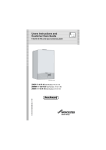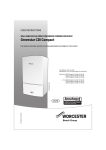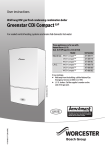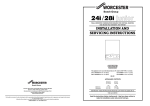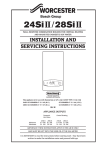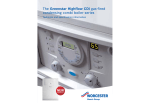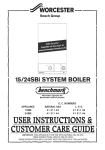Download Worcester 28CDI Operating instructions
Transcript
24CDi, 28CDi & 35CDi II COMBI APPLIANCE 24CDi Fanned Flued (RSF) 24CDi Balanced Flued (BF) 24CDi Open Flued (OF) 28CDi Fanned Flue (RSF) 35CDi II Fanned Flue (RSF) G.C. NUMBERS NATURAL GAS L.P.G. 47 311 30 47 311 31 47 311 29 47 311 32 47 311 33 47 311 34 47 311 35 47 311 58 47 311 59 USER INSTRUCTIONS & CUSTOMER CARE GUIDE EXCELLENCE COMES AS STANDARD Thank you for purchasing a Worcester CDi gas-fired combination appliance. Worcester CDi appliances are made by Worcester Heat Systems and the strictest quality control standards are demanded throughout every stage of production. Indeed, Worcester Heat Systems have led the field in innovative appliance design and performance for more than 30 years. The result is that your new Worcester CDi appliance offers you the very best of everything quality, efficiency, economical running costs, proven reliability and value for money. What’s more, you also have the assurance of our no-nonsense 1 year parts and labour guarantee. And, to keep your boiler operating at peak condition and efficiency, an optional maintenance scheme is available from Worcester Heat Systems Ltd. Contact our Service Contracts team on 01905 754624 for further details. CONTENTS Page No. Operating Instructions .................................... 3-11 Fault and Breakdowns 12 Maintenance and Extended Warranty Information ............ 13-14 Guarantee Details ... 15-16 2 GENERAL INFORMATION GAS SAFETY (INSTALLATION AND USE) REGULATIONS 1998 It is the law that all gas appliances must be installed by a competent person in accordance with the above regulations. Failure to install appliances correctly could lead to prosecution. It is in your interest and that of safety to ensure compliance with the law. The manufacturers notes must not be taken, in any way, as overriding statutory obligations. WARNING: This appliance must be earthed and protected by a 3 amp fuse. ELECTRICITY SUPPLY: 230V ~ 50Hz IMPORTANT: To get the best from your Worcester CDi please read these instructions carefully. NOTE: In the event of a fault the appliance should not be used until the fault has been corrected by a competent person. BENCHMARK The Benchmark initiative is a code of practice to encourage the correct installation, commissioning and servicing of domestic central heating boilers and system equipment. A 'log book' is dispatched with every appliance, This is a vital document that needs to be completed by the installer at the time of installation. It confirms that the boiler has been installed and commissioned according to the manufacturers instructions. All CORGI Registered Installers carry a CORGI ID card and have a registration number. Both should be recorded in your central heating log book. You can check that your installer is CORGI registered by calling CORGI on 01256 372300. Without the completion of the log book, manufacturers may refuse to respond to a call-out request. It is important that your installer has given you the fully completed log book. GENERAL DESCRIPTION (See Fig.1.) The WORCESTER CDi MODELS are combined domestic hot water and central heating appliances. They consist of a gas fired boiler having a varying output of between: CH DHW 24CDi 9.0 - 24kW 9.0 - 24kW 28CDi 9.0 - 24kW 9.0 - 28kW 10.5 - 27.5kW 9.5 - 35.3kW 35CDi II a heat exchanger to provide domestic hot water via the boiler, circulating pump and water diverting valve. All the necessary controls to provide mains fed domestic hot water and central heating. The appliances are supplied as standard with a manual operating switch. Alternatively a facia mounted programmer may have been fitted. The appliances can operate in one of two modes. Hot water only or hot water and central heating. Hot Water Mode: When a demand is made for hot water by opening a tap or shower; the flow switch will energise the pump and circulate primary hot water around the boiler and water to water heat exchanger. The burner will light to its maximum setting. 3 When hot water is no longer required the appliance pump (or fan) may continue to operate to dissipate the residual heat within the boiler. A flow restrictor is fitted within the appliance which limits a hot water delivery rate to a maximum of: 24CDi 28CDi 35CDi II 9.0 (±15%) litres/minute 10.0 (±15%) litres/minute 12.0 (±15%) litres/minute Hot Water and Central Heating mode: Fig. 1. System Diagram. Automatic air vent Circulating pump Water to water heat exchanger When a demand is made for heating by the system controls (i.e. a programmer or room thermostat), the pump will energise, circulating primary water around the heating system and the burner will light. The heat output from the appliance in this mode has been factory set to maximum. The appliance will operate as necessary to maintain the temperature of the radiators at the level set by the Gas to water adjustment of the Heating heat Temperature Control Knob. exchanger (See Fig. 2.) If the system no longer requires output to maintain the desired room temperature, Boiler the burner will extinguish. The pump will continue to run for a short period to dissipate the residual heat from the appliance and then switch off. The appliance will supply Expansion heat to the central heating vessel system as required. A demand for hot water at a tap or shower will override the central heating function for Pressure the period of the domestic hot relief valve water demand. Diverter valve CH Domestic Domestic CH Safety flow hot water cold return discharge out supply 4 GENERAL NOTES CENTRAL HEATING SYSTEM During the first few hours of operation of the central heating system, check that all radiators are being heated at an even rate. Should the upper area of a radiator be at a lower temperature than the base of the radiator, it should be vented by releasing air through the venting screw at the top of each radiator. Make sure your installer shows you how to carry out the operation. Repeated venting will reduce the quantity of water in the system and this must be replenished for safe and satisfactory operation of the appliance. Should water leaks be found in the system or excessive venting be required from any radiator, your installer or heating engineer should be contacted and the system corrected. SEALED HEATING SYSTEM Fig. 1a. The appliance can be fitted to a sealed heating system which is pre-pressurised. In this case your installer will advise you on the minimum and maximum pressure that should be indicated on the pressure gauge. See Fig. 2. Check regularly that this pressure is maintained and contact your installer or maintenance engineer if there is a permanent significant drop in pressure indicated on the gauge. If the system loses pressure it should be re-pressurised as instructed by the installer (N.B. Maximum operating pressure 2.5 bar). Grey Knob Filling Key Re-pressurising The System (See Fig. 1a). (If in doubt leave this procedure to your installer). Remove the bottom panel to gain access to the filling loop assembly. Insert the bayonet end of the filling key into the corresponding cut outs in the filling loop housing and twist to lock the key in place. Turn the grey knob anti-clockwise to allow water ingress and fill until the required pressure is reached. Turn the grey knob clockwise to stop filling and remove the filling key by lining up the bayonet end of the key with the cut outs in the filling loop housing and withdrawing the key. N.B. The key must always be removed from the filling loop housing after the system has been filled to prevent accidental filling and to comply with Bylaw 14 of the Water Bylaws Scheme. Store the key in a safe place for future use and refit the bottom panel. OPEN VENTED HEATING SYSTEM The appliance may be fitted to an open vented heating system your installer will advise you. There is no need to observe the pressure gauge. 5 CLEARANCES 24,28CDi RSF 35CDi II 24CDi OF 24CDiBF Left-hand side Right-hand side In Front Above 10 10 600 180 10 10 600 180 10 10 600 300 10 10 600 100 Below 200 200 200 200 Minimum clearances in millimetres. Your installer will have provided adequate space around the appliance for safety and servicing. Do not restrict this space by the addition of cupboards, shelves etc. close to the appliance. ROOM THERMOSTAT A room thermostat may be fitted for control of the central heating temperature. It will be located in one room of the home. The method of setting a room thermostat varies with the type and manufacture. Refer to the instructions supplied with the room thermostat. THERMOSTATIC RADIATOR VALVES If thermostatic radiator valves are fitted to the system then they must conform to the requirements of BS2767:10. It is advisable to leave one valve permanently set at maximum to prevent the boiler short cycling. SHOWERS, BIDETS, TAPS AND MIXING VALVES Standard hot and cold taps and mixing valves used with the appliance must be suitable for operating at mains pressure. Thermostatically controlled shower valves will guard against the flow of water at too high a temperature. If using a pressure equalising valve, set the Domestic Hot Water temperature control knob to the ‘MAX’ position. Hot and cold mains fed water can be supplied direct to an overrim flushing bidet subject to local water company requirements. With all mains fed systems the flow of water from the individual taps will vary with the number of outlets operated simultaneously and the cold water mains supply pressure to the property. Flow balancing using ‘Ball-o-Fix’ type valves is recommended to avoid an excessive reduction in flow to individual outlets. For further information contact Worcester Heat Systems Technical Helpline. 08705 266241 HOT AND COLD FLOW The flow of water demanded from both hot and cold service outlets is dependent upon mains supply, it may not be possible in some installations to operate all outlets simultaneously. WATER MAINS FAILURE It is important to note that in the event of a mains water supply failure, no tap water will be available until the mains supply is restored. The appliance can still be used for heating provided that the system is of the sealed system type. Open vent central heating systems should be turned off until the supply is restored. USE IN HARD WATER AREAS 6 Normally there is no need for scale protection. However, in areas of exceptionally hard water supply it is recommended that an In-Line scale inhibitor be fitted. Installation should be strictly in accordance with the requirements of the local Water Company. An isolating valve to facilitate servicing should be incorporated The water hardness may be determined using the standard test paper or by reference to the local Water Company. Further information may be obtained from Worcester Heat Systems Technical Helpline. AIR SUPPLY FOR OPEN FLUED (O.F.) APPLIANCES Your installer will have made arrangements for an adequate supply of fresh air to the appliance. Fresh air is required for combustion. Do not block up any air ways which may be let into a wall or door. Do not hang clothes or other combustible materials over the appliance or against the flue pipe. NOTE: Do not place anything on top of the appliance. If the appliance is fitted in a compartment do not use the compartment for storage purposes unless it conforms to the requirements of BS 6798:1987: Section 6. In particular, the flue pipe should not pass through an airing cupboard space unless protected by a guard (such as wire mesh) concentrically spaced 13mm (1/2in), as described in BS 6798:1987. VENTILATION OF BALANCED FLUED (BF) AND ROOM SEALED FANNED FLUE (RSF) APPLIANCES These are room sealed appliances and any ventilation openings in a wall or door must not be obstructed. Do not allow the flue terminal fitted on the outside wall to become obstructed or damaged. NOTE: Do not place anything on top of the appliance. If the appliance is fitted in a compartment do not use the compartment for storage purposes unless it conforms to the requirements of BS 6798:1987: Section 6. It is essential that the airing space is separated from the boiler space by a perforated non-combustible partition as described in BS 6798:1987. CIRCULATING PUMP This may be fitted with a speed adjuster. If so it will be factory set at maximum and should not be changed. FROST PRECAUTIONS If the appliance is not to be used for a long period of time and there is a likelihood of freezing, then the appliance should be drained. The Worcester Heat Systems Technical Helpline will advise you on suitable frost precautions. For short periods, the built-in frost protection of the appliance will be adequate. SERVICE Annual servicing is important to ensure continuing high efficiency and long life of your appliance. Suitable servicing arrangements should be made with a competent third party. In the event of any difficulty in making suitable service arrangements, Worcester Heat Systems Ltd. will be happy to discuss regular servicing and offer a comprehensive maintenance contract. IMPORTANT: Do not touch or adjust any sealed compontent. WARNING If a gas leak exists, or is suspected, turn off the gas supply to the appliance at the service cock and consult your local service engineer. Do not touch any electrical switches to turn them either on or off. Open all windows and doors. Do not smoke. Extinguish all naked lights. CLEANING Do not use abrasive cleaners on the outer casing. Use a damp cloth and a little detergent. 7 OPERATION OF CONTROLS OPERATING SWITCH In the ‘ ’ position there is no mains electricity to the appliance. In the ‘I’ position mains electricity is connected to the appliance. CENTRAL HEATING TEMPERATURE CONTROL The position of this knob will determine the temperature of the water delivered to the radiators between the ‘I’ and ‘MAX’ position. When the knob is turned anti-clockwise past the ‘I’ position towards the ‘ ’ (Summer Position), then the appliance will operate in the HOT WATER mode only and no heat will be delivered to the radiators. DOMESTIC HOT WATER TEMPERATURE CONTROL The position of this knob will determine the temperature of the water delivered at the domestic hot water taps between the ‘ ’ and the ‘MAX’ position. By slightly reducing the flow of domestic water from the tap, the delivery temperature of the water will be further increased. This is of particular advantage in the winter, for example to increase bath water temperature. Also this will provide an added advantage of reducing the delay before hot water is obtained. FACIA MOUNTED PROGRAMMER (if fitted) Your installer may have mounted either a mechanical or an electronic programmer into the facia of your appliance. Operating instructions are supplied with the programmer. RESET BUTTON Press this button in for five seconds if any of the indicator lights are flashing slowly. SYSTEM PRESSURE GAUGE The red needle has been set to show the sealed system pressure which is required for the appliance to operate effectively. The grey needle will show the actual pressure in the system. This does not apply to any open vent system. 8 INDICATOR LIGHTS Mains electricity indicator: OFF : No mains electricity to the appliance ON : Mains electricity is connected to the appliance Central heating demand indicator: OFF : No demand for heat to the central heating circuit ON : Central heating demand FLASHING SLOW : Ignition lockout (once per second) FLASHING FAST : Appliance fault (other than ignition (five times per second) lockout) Domestic hot water demand indicator: OFF : No demand for domestic hot water ON : Domestic hot water demand FLASHING FAST : Air flow fault (RSF). Flue gas spillage (OF) (five times per second) Central heating and domestic hot water demand indicators: BOTH FLASHING SLOW : Overheat cut-off (once per second) Flame detection indicator: OFF : Burner off ON : Burner on Fig. 2. Controls. Central heating demand indicator DHW demand indicator Flame detection Reset indicator button Mains electricity indicator Operating CH temperature switch control knob DHW temperature control knob Sealed system pressure gauge 9 TO LIGHT AND STOP THE APPLIANCE TO LIGHT THE APPLIANCE Check that the water valves to the central heating circuit are open. On sealed systems check that the grey needle on the pressure gauge is not below the required pressure. Switch on the mains electricity. The green power on indicator will light. Set the room thermostat, if fitted, to maximum. Turn the central heating temperature control knob to ‘MAX’. The red central heating demand indicator will light. The burner will light and the red flame detection indicator will light. Set the central heating and hot water temperature control knobs and the room thermostat, if fitted, to the desired temperature. TO STOP THE APPLIANCE For Short Periods Turn the central heating temperature control knob fully anticlockwise to the ‘ ’ position. For Long Periods Turn the operating switch to the ‘ ’ position. Switch off the mains electricity. A facia mounted electronic programmer will retain its settings for about two weeks, after which it will return to the factory set programme. The display will disappear after approximately 12 hours. Fig. 3. CDi with front panel removed. A facia mounted mechanical programmer will require resetting once the operating switch has been set to ‘O’, or the mains supply has been Clip disconnected. ELECTRICITY SUPPLY FAILURE Expansion vessel Circulating pump Locating peg Gas valve 10 If the electricity supply fails the appliance will not operate. Once the supply is restored the appliance will return to normal operation. If a programmer is fitted, check that the settings have been maintained. OVERHEAT CUT-OFF THERMOSTAT The appliance will enter a lockout condition in the event of overheating. An overheat cut-off thermostat is fitted to the appliance which will interrupt the electricity supply to the gas valve. If the overheat cut-off has operated, both the central heating and the hot water demand indicators will flash together.














































